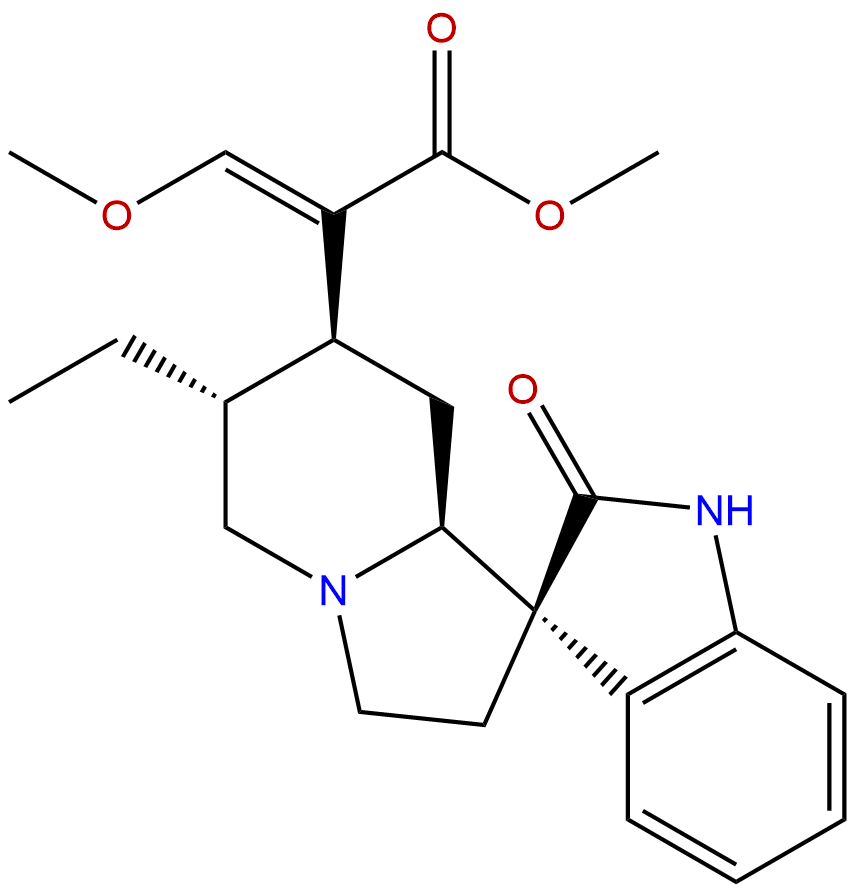
RhynchophyllineCAS No.:76-66-4 |
||||||||||
 |
|
|
||||||||

| Catalogue No.: | BP1216 |
| Formula: | C22H28N2O4 |
| Mol Weight: | 384.476 |
| Botanical Source: | Uncariae Ramulus cum Uncis |
Synonym name: Mitrinermine
Catalogue No.: BP1216
Cas No.: 76-66-4
Formula: C22H28N2O4
Mol Weight: 384.476
Botanical Source: Alkaloid from Uncaria rhyncophylla, some other Uncaria spp., several Mitragyna spp. and Cephalanthus occidentalis (Naucleaceae)
Purity: 95%~99%
Analysis Method: HPLC-DAD or/and HPLC-ELSD
Identification Method: Mass, NMR
Packing: Brown vial or HDPE plastic bottle
Can be supplied from milligrams to grams.
For Reference Standard and R&D, Not for Human Use Directly.
Inquire for bulk scale.
Description:
Rhynchophylline, a noncompetitive antagonist of the NMDA receptor, which has anti-inflammatory, anti-hypertension, cardiacprotective and neuroprotective activities. Rhynchophylline can markedly inhibit rabbit platelet aggregation induced by ADP or thrombin possibly by depressing the inflow of Ca2+ and the rise of the cytoplasmic free calcium level in platelet.Rhynchophylline can reduce the systolic blood pressure (SBP) of spontaneously hypertensive rats (SHR) significantly, decrease plasma Ang II, ADMA, and AT1R levels, and promote serum NO and NOS levels, which has the protection of vascular endothelial function.
References:
Fitoterapia. 2014 Oct;98:166-73.
Effects of rhynchophylline on GluN1 and GluN2B expressions in primary cultured hippocampal neurons.
N-methyl-d-aspartate (NMDA) receptor subunits GluN1 and GluN2B in hippocampal neurons play key roles in anxiety. Our previous studies show that Rhynchophylline, an active component of the Uncaria species, down-regulates GluN2B expression in the hippocampal CA1 area of amphetamine-induced rat.
METHODS AND RESULTS:
The effects of Rhynchophylline on expressions of GluN1 and GluN2B in primary hippocampal neurons in neonatal rats in vitro were investigated. Neonatal hippocampal neurons were cultured with neurobasal-A medium. After incubation for 6h or 48 h with Rhynchophylline (non-competitive NMDAR antagonist) and MK-801 (non-competitive NMDAR antagonist with anxiolytic effect, as the control drug) from day 6, neuron toxicity, mRNA and protein expressions of GluN1 and GluN2B were analyzed. GluN1 is mainly distributed on neuronal axons and dendritic trunks, cytoplasm and cell membrane near axons and dendrites. GluN2B is mainly distributed on the membrane, dendrites, and axon membranes. GluN1 and GluN2B are codistributed on dendritic trunks and dendritic spines. After 48 h incubation, a lower concentration of Rhynchophylline (lower than 400 μmol/L) and MK-801 (lower than 200 μmol/L) have no toxicity on neonatal hippocampal neurons. Rhynchophylline up-regulated GluN1 mRNA expression at 6h and mRNA and protein expressions at 48h, but down-regulated GluN2B mRNA and protein expressions at 48 h. However, GluN1 and GluN2B mRNA expressions were down-regulated at 6h, and mRNA and protein expressions were both up-regulated by MK-801 at 48h.
CONCLUSIONS:
These findings show that Rhynchophylline reciprocally regulates GluN1 and GluN2B expressions in hippocampal neurons, indicating a potential anxiolytic property for Rhynchophylline.
Phytother Res. 2012 Oct;26(10):1528-33.
Rhynchophylline attenuates LPS-induced pro-inflammatory responses through down-regulation of MAPK/NF-κB signaling pathways in primary microglia.
Excessive activation of microglial cells has been implicated in various types of neuroinflammation. Suppression of microglial activation would have therapeutic benefits, leading to the alleviation of the progression of neurodegeneration.
METHODS AND RESULTS:
In this study, the inhibitory effects of Rhynchophylline (RIN), a tetracyclic oxindole alkaloid component isolated from Uncaria rhynchophylla (Miq.) Jacks., on the production of pro-inflammatory mediators were investigated in lipopolysaccharide (LPS)-stimulated microglia. The results showed that RIN markedly reduced the production of nitric oxide (NO), prostaglandins E(2) (PGE(2) ), monocyte chemoattractant protein (MCP-1), tumor necrosis factor-α (TNF-α) and interleukin-1β (IL-1β) in LPS-activated microglia. The mRNA expression levels of iNOS and COX-2 were also depressed by RIN in a concentration-dependent manner. Further studies revealed that RIN blocked IκBα phosphorylation and degradation, inhibited the phosphorylation of mitogen-activated protein kinases (MAPKs).
CONCLUSIONS:
In summary, these data suggest that RIN suppresses inflammatory responses of microglia and may act as a potential therapeutic agent for various neurodegenerative diseases involving neuroinflammation.
Am J Chin Med. 2009;37(2):351-60.
Uncaria rhynchophylla and Rhynchophylline inhibit c-Jun N-terminal kinase phosphorylation and nuclear factor-kappaB activity in kainic acid-treated rats.
Our previous studies have shown that Uncaria rhynchophylla (UR) can reduce epileptic seizures.
METHODS AND RESULTS:
We hypothesized that UR and its major component Rhynchophylline (RH), reduce epileptic seizures in rats treated with kainic acid (KA) by inhibiting nuclear factor-kappaB (NF-kappaB) and activator-protein-1 (AP-1) activity, and by eliminating superoxide anions. Therefore, the level of superoxide anions and the DNA binding activities of NF-kappaB and AP-1 were measured. Sprague-Dawley (SD) rats were pre-treated with UR (1.0 g/kg, i.p.), RH (0.25 mg/kg, i.p.), or valproic acid (VA, 250 mg/kg, i.p.) for 3 days and then KA was administered intra-peritoneal (i.p.). The results indicated that UR, RH, and VA can reduce epileptic seizures and the level of superoxide anions in the blood. Furthermore, KA was demonstrated to induce the DNA binding activities of NF-kappaB and AP-1. However, these inductions were inhibited by pre-treatment with UR, RH, or VA for 3 days. Moreover, UR and RH were shown to be involved in the suppression of c-Jun N-terminal kinase (JNK) phosphorylation.
CONCLUSIONS:
This study suggested that UR and RH have antiepileptic effects in KA-induced seizures and are associated with the regulation of the innate immune system via a reduction in the level of superoxide anions, JNK phosphorylation, and NF-kappaB activation.